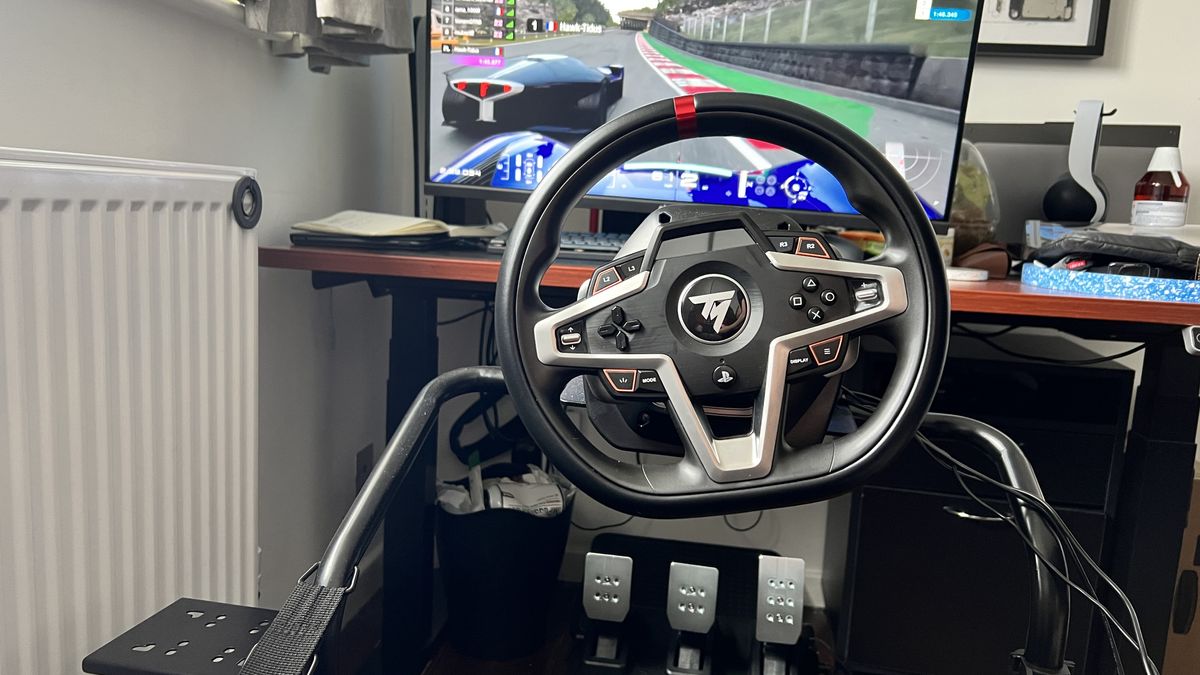Laptop Mag Verdict
The Thrustmaster T248 is a great sim racing wheel for beginners — packing immersive force feedback, impressive pedals and an (almost) well-thought-out design at a good price.
Pros
- +
Sleek aesthetic and durable build
- +
Realistic, immersive force feedback
- +
Tactile, well-placed buttons
- +
Awesome pedals
- +
Affordable price
Cons
- -
Plastic build feels cheap
- -
Steering can feel gritty at times
- -
Paddle shifts are so loud
Why you can trust Laptop Mag
The Thrustmaster T248 may just be the perfect wheel for any beginner sim racer who fell in love with Drive to Survive and wants to pull off some almighty dive-bomb overtakes that would make Max Verstappen proud.
Unlike dirt-cheap steering wheels, the T248 has some Thrustmaster innovations like a hybrid force feedback system, an impressive set of pedals and really well-placed buttons for quick changes on the fly. This is despite the $399, which is pretty cheap for a gaming wheel.
Still, this is a lower-cost sim racing wheel, and as you can tell by the score, it’s not perfect. Let’s get into why.
Thrustmaster T248 price and availability
The Thrustmaster T248 comes in at $399/£299, which just about matches the price of the Logitech G923 (except for the £50 increase in the UK), to give you a clear picture of the beginner’s market Thrustmaster is targeting here.
Don’t get me wrong, there are cheaper options out there. But if you want to turn sim racing into a bit of a hobby, set yourself the expectation of paying a price like this in order to get a decent feature set and force feedback that is strong enough for immersion.
However, it’s worth noting that the T248 is regularly discounted in sales and at random times. Right now, you can snap one up at $349 on Amazon (US) or £282 on Amazon (UK).
Thrustmaster T248 design
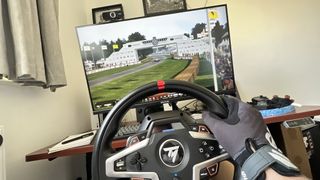
Let’s start with the hardware you’re going to pull out of the box. The brushed gunmetal grey and black aesthetic looks pretty slick. The wheel itself is of a smaller size than you’d find on more expensive wheels, but provides a decent enough diameter (11 x 11 inches) that won’t give your arms too much fatigue due to over-rotation.
The metal pedals have an impressively premium look and feel to them, the on-wheel buttons are satisfyingly clicky with no real spongy sensation to them, and the wheel base itself packs all the force feedback tech into a pretty compact frame that will fit into any small setup with a depth of 11 inches.
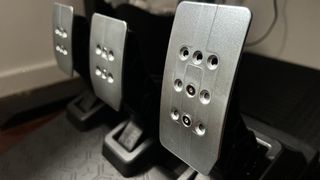
But this is a cheaper racing wheel. While you can feel that throughout the plastic build of the T248, which falls short of the Logitech G923’s slightly more premium construction , it does feel durable with no creaking under any serious gripping pressure.
The all-plastic build of the wheel feels pretty cheap and the cushioning seems misplaced. Don’t get me wrong, the soft outside of the rim is nice, but if you had to be economical with the padding, surely it would be better on the inside where your fingers are going to feel the strain more with a hard grip.
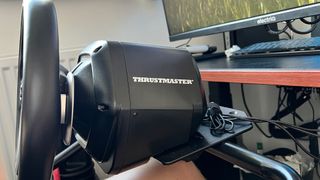
Thrustmaster T248 setup
Setup is an absolute doddle for the Thrustmaster T248. The attachment system makes it easy to attach to your desk, screw holes are placed perfectly for use across pretty much all racing sim seats like the Next Level GT Lite that I use , and you can plug in and play without the need for additional drivers.
Cable management is easy enough too, as channeling is built into the wheel and pedals and the medium length of all the wires themselves mean you can keep your sim setup relatively clean and reduce any chances of tripping.
Once you’re driving, while the console compatibility is just a case of connecting it up, the PC side of things opens up a world of future driver updates. Rather than having a standalone piece of software running in the background, this is just accessed in your peripheral settings, just like your mouse and keyboard.
Thrustmaster T248 performance
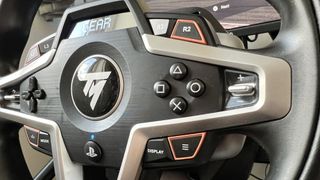
Now, you fire it up and drive. How does it perform? In one short phrase, pretty good for what you pay!
For context, I tested this wheel across several games: Gran Turismo 7, F1 22 and Assetto Corsa Competizione (ACC) on PS5, along with Forza Horizon 5, Assetto Corsa and Beam.NG on my Asus TUF Gaming F15.
While there are some game-specific differences, such as the increased challenge of controlling oversteer in F1 22 and the tyre modeling of ACC, the consistency of immersion across all of them is solid.
This comes down to a few key features. First, many players will feel disappointed at the lack of a direct drive system, but the combination of a gear and belt-driven force feedback delivers solid feedback to your steering interactions.
The updated system provides 70% more force feedback than the previous generation T150, which you can really feel in its weighty steering This does an admirable job of giving you the impression that you’re wrestling a heavy racing car around corners. And this was at the lower end of the force feedback settings (FFB1). If you want a little extra spice, crank it up to FFB3 and enjoy the workout that comes with it.
Granted, you can feel the gears at times in this hybrid system, which leads to turning feeling a bit granular, but for what you get at this cost, it’s a great first wheel that teaches you the sensations to look out for when controlling a car.
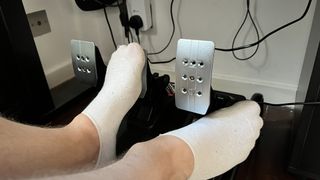
Second, the T3PM pedals are in a class of their own at this price. The surface area of each pedal is generous with a subtle convex bend that cups nicely into the natural curvature of your feet.
Each of the magnetic pedals have a smooth motion and are able to detect minute degrees of pressure, and the option to customize the brake spring means you can tune the experience to your needs. Once you get the feel just right for you, this unlocks plenty of opportunities to work on your race craft — be it learning to trail brake around the downhill corners of Bathurst or figuring out the earliest possible place to apply acceleration coming out of the Tsubuka hairpin.
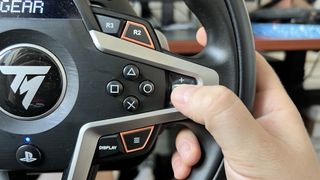
Third, the 25 action buttons give you a vast amount of control over in-car options, and the two dual-position encoders on the sides are perfectly placed for you to flick through GT7’s MFD and alter options like adjusting your fuel mapping or brake balance.
And finally, the unique selling point of the T248 that no other steering wheel around this cost has: the dashboard display. It’s a basic dot matrix display with a backlight, which only presents one line of information, but it can be customized to give you different types of information, including revs, grid position, lap times, and personal bests.
On paper, it seems like a gimmick, but once you find your optimal use cases (for example, I use the personal best screen on F1 22 to maintain a consistently fast lap time in races, along with the rev counter in GT7 to time my gear shifts), the usefulness starts to become apparent. Plus, it is your window to many on-wheel settings, such as adjusting the force feedback and max wheel rotation.
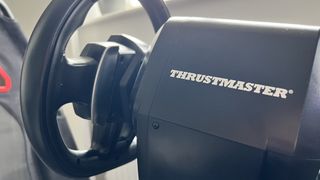
Like any budget gadget, it does come with some downsides. None are more apparent than those magnetic paddle shifters. The force needed to activate them does give them a nice, tactile feel, but good grief the click is so loud. Even with headphones on, you can hear that snap of the paddle hitting the plastic as they shoot back into position.
Look, I know Thrustmaster are trying to keep the price down, but did nobody think to just put a basic adhesive fabric pad on the shift mechanism enclosure, to cushion the sound? It’s not a deal breaker, as you can drown them out by cranking your headset up to full blast, but they make any sort of gameplay through the speakers virtually impossible.
Bottom Line
In the T248, Thrustmaster has created a solid sim racing wheel for beginners. The force feedback is stronger than its similarly priced competition, button placement is optimal for quick alterations while you drive, the display is a nice added extra, and the pedals feel great.
Most of its problems come down to cost cutting and a particularly weird design decision. The plastic construction feels cheap, wheel rotation has a weird gritty sensation to it, and those paddle shifters are ungodly loud.
But when it comes down to picking a first wheel, this is a good option for beginners that is simple to set up and provides a strong experience across all the top racing sims.

Jason brought a decade of tech and gaming journalism experience to his role as a writer at Laptop Mag, and he is now the Managing Editor of Computing at Tom's Guide. He takes a particular interest in writing articles and creating videos about laptops, headphones and games. He has previously written for Kotaku, Stuff and BBC Science Focus. In his spare time, you'll find Jason looking for good dogs to pet or thinking about eating pizza if he isn't already.
